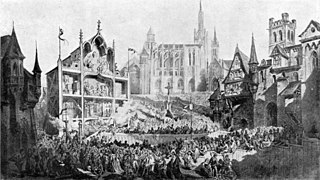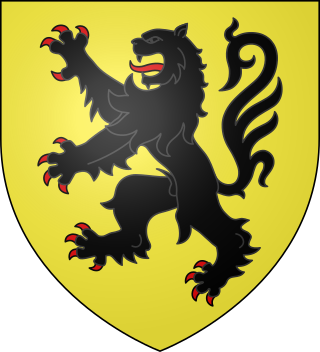Related Research Articles

Cheshire is a ceremonial county in North West England. It is bordered by Merseyside to the north-west, Greater Manchester to the north-east, Derbyshire to the east, Staffordshire to the south-east, and Shropshire to the south; to the west it is bordered by the Welsh counties of Flintshire and Wrexham, as well as a short coastline on the Dee Estuary. Warrington is the largest settlement, and the city of Chester is the county town.

Mystery plays and miracle plays are among the earliest formally developed plays in medieval Europe. Medieval mystery plays focused on the representation of Bible stories in churches as tableaux with accompanying antiphonal song. They told of subjects such as the Creation, Adam and Eve, the murder of Abel, and the Last Judgment. Often they were performed together in cycles which could last for days. The name derives from mystery used in its sense of miracle, but an occasionally quoted derivation is from ministerium, meaning craft, and so the 'mysteries' or plays performed by the craft guilds.

Chester is a cathedral city and the county town of Cheshire, England, on the River Dee, close to the England-Wales border. With a population of 79,645 in 2011, it is the most populous settlement of Cheshire West and Chester and serves as its administrative headquarters. It is also the historic county town of Cheshire and the second-largest settlement in Cheshire after Warrington.

John Rogers was an English clergyman, Bible translator and commentator. He guided the development of the Matthew Bible in vernacular English during the reign of Henry VIII and was the first English Protestant executed as a heretic under Mary I of England, who was determined to restore Roman Catholicism.

The history of Cheshire can be traced back to the Hoxnian Interglacial, between 400,000 and 380,000 years BP. Primitive tools that date to that period have been found. Stone Age remains have been found showing more permanent habitation during the Neolithic period, and by the Iron Age the area is known to have been occupied by the Celtic Cornovii tribe and possibly the Deceangli.

The American Academy of Religion (AAR) is the world's largest association of scholars in the field of religious studies and related topics. It is a nonprofit member association, serving as a professional and learned society for scholars involved in the academic study of religion. It has some 10,000 members worldwide, with the largest concentration being in the United States and Canada. AAR members are university and college professors, independent scholars, secondary teachers, clergy, seminarians, students, and interested lay-people.

The Treaty of Athis-sur-Orge was a peace treaty signed on 23 June 1305 between King Philip IV of France and Robert III of Flanders. The treaty was signed at Athis-sur-Orge after the Battle of Mons-en-Pévèle and concluded the Franco-Flemish War (1297-1305).

New Inn Hall was one of the earliest medieval halls of the University of Oxford. It was located in New Inn Hall Street, Oxford.

Pisistratus was a politician in ancient Athens, ruling as tyrant in the late 560s, the early 550s and from 546 BC until his death. His unification of Attica, the triangular peninsula of Greece containing Athens, along with economic and cultural improvements laid the groundwork for the later pre-eminence of Athens in ancient Greece. His legacy lies primarily in his institution of the Panathenaic Games, historically assigned the date of 566 BC, and the consequent first attempt at producing a definitive version of the Homeric epics. Pisistratus' championing of the lower class of Athens is an early example of populism. While in power, he did not hesitate to confront the aristocracy and greatly reduce their privileges, confiscating their lands and giving them to the poor. Pisistratus funded many religious and artistic programs, in order to improve the economy and spread the wealth more equally among the Athenian people.

St Botolph-without-Bishopsgate is a Church of England church in the Bishopsgate Without area of the City of London, and also, by virtue of lying outside the city's eastern walls, part of London's East End.
Robert de Limesey was a medieval cleric. He became Bishop of Chester in 1085, then his title changed to Bishop of Coventry when the see was moved in 1102.
The following is a bibliography of New York. New York is a U.S. state in the Mid-Atlantic region of the Northeastern United States. New York is commonly known as the "Empire State" and sometimes the "Excelsior State". It is the nation's third most populous state at over 19 million people. The capital of the state is Albany and its most populous city is New York City. New York is often referred to as New York State to distinguish it from New York City.

Robert Booth (1662–1730), an aristocratic 18th-century Anglican priest, served as Archdeacon of Durham from 1691 and also as Dean of Bristol from 1708.
The Bishop of Chester is the Ordinary of the Church of England Diocese of Chester in the Province of York.

William Cowper of Overleigh Hall, Cheshire, was a British physician and antiquarian.
George Taylor, M.A. was Rector of Aldford from 1769 until his death; and Archdeacon of Chester from 21 January 1786 to his resignation on 20 November 1786.
Abel Ward was Archdeacon of Chester from his installation on 20 April 1751 until his death on 1 October 1785.
The Venerable Edmund Entwisle, D.D. was an Anglican clergyman.
Robert Perceval was an Anglican priest in the 16th-century.
Robert Dorset was a Sixteenth-century English priest.
References
- ↑ History of the City of Chester
- ↑ "Catalogue of the Harleian Manuscripts in the British Museum" p521: London; King George; 1808
- ↑ Foster, Joseph (1888–1892). . Alumni Oxonienses: the Members of the University of Oxford, 1500–1714 . Oxford: Parker and Co – via Wikisource.
- ↑ "History of the city of Chester, from its foundation to the present time : with an account of its antiquities, curiosities, local customs, and peculiar immunities ; and a concise political history" Hemingway, J Chester' J. Fletcher; 1831 p.325
- ↑ Horn, Joyce M.; Smith, David M.; Mussett, Patrick (2004), Fasti Ecclesiae Anglicanae 1541–1857, vol. 11, pp. 45–47